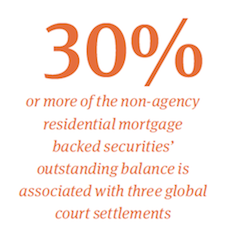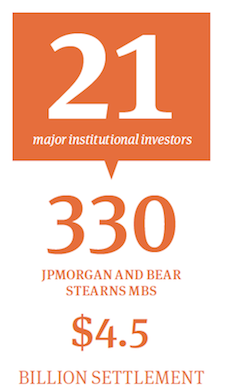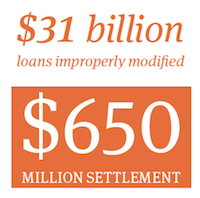Early on in 2015, ratings agency DBRS released a note to clients seeking to quantify the risks of mortgage servicing in 2015. The research report read as a venerable laundry list of to-dos for mortgage servicers to adhere to new standards from the Consumer Financial Protection Bureau.
“DBRS also believes that throughout 2015, servicers will continue to be under increased regulatory scrutiny and subject to fines and mortgage enforcement issues related to non-compliance with the mortgage servicing rules, particularly as it relates to Mortgage Servicing Rights transfers,” the note stated.
So 2015 may very well be remembered as the year mortgage servicing got its act together. And on a lesser note, this year may also be remembered as one particular “elephant in the room” legacy from the subprime era finally resolved.
Over 30% of the non-agency residential mortgage backed securities outstanding balance is associated with three global court settlements — Countrywide, JPMorgan and Citi — according to FTN Financial.
These settlements, between bondholders and bankers over legacy loans that were downgraded to junk, could potentially benefit all investors in covered RMBS trusts.
However, timing of the settlement payment is crucial in determining which bondholders come out as winners. “Payment priorities can change by the time allocations are paid out,” wrote FTN Financial analysts, led by Walt Schmidt, in a 2015 outlook report.
“Some bonds may crossover, allowing the bond next in line to benefit from the settlement. Incorporating a cash settlement into a cash flow will significantly shorten a bond’s average life in most cases. The cash flows through the trusts as if it is an unscheduled principal payment.”
Deutsche Bank Securities analysts, led by Ying Shen, wrote in a securitization report that the ability to quantify potential payouts continues to separate good investments from bad.
“We expect more settlement agreement proposals … have been playing an important and levered role in the market as legacy RMBS yields keep grinding tighter,” wrote Shen.
 Approximately 14% of non-agency outstanding balance is associated with BofA’s $8.5 billion Countrywide settlement. Three years after the Countrywide settlement was announced, a resolution looks likely to be finalized this year. On March 5, a New York appeals court unanimously approved the Countrywide trustee’s proposed rep and warranty settlement in its entirety. As of publication, only a few hurdles remain for the settlement.
Approximately 14% of non-agency outstanding balance is associated with BofA’s $8.5 billion Countrywide settlement. Three years after the Countrywide settlement was announced, a resolution looks likely to be finalized this year. On March 5, a New York appeals court unanimously approved the Countrywide trustee’s proposed rep and warranty settlement in its entirety. As of publication, only a few hurdles remain for the settlement.
The court found that as a trustee, BNY Mellon properly exercised its discretion in settling all the claims, including repurchase claims against loan modifications that had been previously excluded by Judge Kapnick’s decision in 2014.
The BofA/Countrywide settlement was first announced in summer 2011. Although the settlement was supported by the majority of large institutional investors in the settling trusts, including PIMCO and BlackRock, a group of minority investors in the settling trusts raised objections to the settlement. The minority investors contended, among other things, that the settlement amount was at least $2 billion too low, and that Bank of New York as trustee was conflicted due to its business relationships with BofA.
Numerous objectors including AIG, Triaxx, Scott + Scott, and American Fidelity Assurance filed motions to reargue and appeal.
BofA has now successfully reached side settlements with some of the largest objectors — including AIG and Triaxx — since the second half of 2014.
However, analysts at Barclays said that appeals from other objectors remain an obstacle for payment.
Triaxx removed its objection in October. The bondholder originally filed an appeal to the Countrywide settlement in March 2014 stating that the settlement failed to cover claims that as much as $31 billion of loans were improperly modified.
American International Group Inc., the largest commercial insurer in the U.S. and Canada, withdrew its objections in July after settling with the bank for $650 million. AIG had sued Bank of America for $10 billion in damages in 2011.The March 5 decision means that trustees could potentially distribute $8.5 billion in recoveries to affected bonds, with investors seeing the settlement payout delivered to the covered trusts over the next eight to 12 months.
“A verdict approving the deal in its entirety would be a big positive for the bondholders who still await cash from the settlement,” Barclays analysts stated in a securitization report.
“It might also provide Bank of America with further weight in its state court arguments against the re-appeals, perhaps even make the remaining objectors more amenable to an out-of-court settlement and mark an end to this long-running legal process.”
Citigroup and JPMorgan settlements
The JPMorgan settlement has begun the process of receiving court approval. The case involves mortgage securities put together by Bear Stearns before it went under during the 2008 financial crisis and was acquired by JPMorgan.
JPMorgan Chase reached a $4.5 billion settlement with bondholders to resolve allegations that the bank breached representations and warranties to private investors in 330 JPMorgan and Bear Stearns mortgage-backed securities trusts in 2013. Gibbs & Bruns negotiated the JPMorgan settlement on behalf of 21 major institutional investors, including BlackRock, Pimco, Goldman Sachs and MetLife.
Approximately 16% of the non-agency outstanding balance is associated with the settlement, according to FTN. The payout of $4.5 billion is 6.6% of the total realized and expected collateral losses on the 330 deals and represents 6% of the collateral balance outstanding on these deals.
This is 37% less than the payout ratio in the Countrywide settlement, where Bank of America agreed to pay out 10.8% of total losses.
Under the settlement agreement, JPMorgan will retain approximately $262million of the proposed $4.5 billion settlement payout that would otherwise have been distributed to these 19 rejecting loan groups. Consequently, the accepting trusts will receive cash totaling approximately $4.2 billion upon court approval.
A group of mostly small investors say the deal worked out by institutional investors is too low and should not be “railroaded” through. The holdout group ranges from the Federal Home Loan Bank of Boston to the Construction Laborers Pension Trust for Southern California.
Lawyers representing these bondholders argued “that institutional investors who negotiated the settlement owned only 32% interest in the 330 covered trusts, and other certificate holders should also be privy to what went on in the negotiation process.”
Citigroup, on the other hand, has yet to have the trustees sign off on the $1.12 billion settlement. On Feb. 1, the New York Supreme Court signed a show cause order, scheduling the first oral hearing for the Citigroup settlement case on May 19, 2015.
Investors who oppose the deal had until April 17 to file their objections, and trustees have 17 days after that to file their response to the objections.
RMBS trustees had earlier accepted Citigroup’s $1.125 billion settlement for the vast majority of the 68 trusts involved and filed for judicial instruction in December.
The settlement covers 68 securitization trusts that issued a combined $59.4 billion in mortgage-backed securities from 2005 to 2008, according to a statement issued by Citigroup. The proposed payout ratio in the Citi settlement is 8% of total losses and represents 3% of the non-agency outstanding balance.
The bank and a group of 19 institutional investors, represented by Gibbs & Bruns LLP, negotiated the pact. The deal currently holds more than $5.3 billion of the unpaid principal balance of the securities, according to the petition.
The trustees approached the Citigroup settlement much the same way as they approached the JPMorgan settlement proposed a few months ago. Their advisors had earlier recommended that they accept the $1.125 billion offer for the majority of the trusts and the trustees rejected the offer for only seven deal groups (across four deals). Similar to the JPMorgan case, Citigroup has the option to exclude certain deals from the settlement; hence, the settlement approval can be expedited for trusts with no objectors.
“Given the high degree of similarity between the Citi and JPM settlements, and the fact that the same judge is presiding over both cases, the procedure and outcome of both settlements could be similar,” stated Barclays analysts.
“If the JPM settlement is a guide, at least a few objectors might intervene; nonetheless, it remains to be seen whether and how many objections would be raised for these deals. Like JPM, Citigroup has the option to exclude certain deals from the settlement…Overall, we continue to believe that settlement will be approved and that payouts might be made to most of the trusts by end of this year, soon after payments are made in the JPM settlement.”
The appeals court approval for the Countrywide settlement bodes well for JPMorgan and Citi, according to Barclays.
“Although the objections against JPM and Citigroup are of a somewhat different nature (unlike in Countrywide’s case, the trustees were not active participants in the negotiations that were held between institutional investors and JPM/Citigroup), this verdict likely clarifies the standard against which trustees will be judged,” Barclays said in a client note. “As such, we believe that the likelihood of faster progress on the approval process in the JPM and Citigroup settlements has risen.”
A new target for investors looking to recover RMBS will be the trustees. In addition to the on-going global settlement cases, new lawsuits were issued last year between investors and trustees. This new type of litigation was initiated for investors to recover their losses on RMBS by accusing trustees of negligence and breach of contract.
On June 18, 2014, investors including BlackRock and PIMCO filed six lawsuits in New York State Supreme Court against the six most prominent MBS Trustees: Bank of New York Mellon, U.S. Bank, Wells Fargo, Citibank, Deutsche Bank, and HSBC. The complaint covers 2,200 residential mortgage-backed securities trusts established between 2004 and 2008. The complaint against U.S. Bank alone points to 841 RMBS private label trusts for which the bank was trustee, containing $771 billion of loans securitized between 2004 and 2008.
The crux of their argument is that trustees didn’t act on evidence that banks failed to comply with their own underwriting criteria. Investors can’t access the underlying loan files and other documents to confirm compliance with the deal’s contractual representations and warranties, and they can’t monitor the loan servicers’ conduct or enforce a trust’s contractual rights.
Consequently, they “must rely on the trustee to protect their interests,” and trustees not only failed to do so, but at times appeared to thwart investor interests, according to the complaint.
Investors contend that one of the trustees, U.S. Bank, admitted its knowledge of breaches of reps and warrants when it pursued its own legal action against the same loan originators and RMBS sponsors, alleging the same “systemic and pervasive breaches of representations and warranties” that the RMBS trusts have pursued.
“This next wave of litigation could have a significant impact on deals if the settlements materialize,” according to FTN analysts. “Quantifying the impact of the cash settlements is imperative as settlements are poised to be resolved within the next year and a half.”
FIGHTING BACK: NOMURA AND RBS
In January of 2015 two banks decided to fight back against the FHFA instead of settling. Nomura Holdings and the Royal Bank of Scotland ’s trial with the Federal Housing Finance Agency is the first out of 18 lawsuits to reach trial. As of press time, all sides had presented their closing arguments and the decision was in the hands of U.S. District Judge Denise Cote.
According to one report, Nomura’s penalty is estimated not to exceed $300 million, which pales in comparison to the penalties paid by BofA, Chase and Citi, but that’s not stopping the companyfrom fighting back.Nomura claims that its U.S. unit did not knowingly sell bonds backed by fraudulently originated loans to Fannie Mae and Freddie Mac in the run-up to the crisis, and claims that Fannie and Freddie may not lose money on the Nomura bonds. According to a Bloomberg report, Nomura claimed that its analysis shows that Fannie Mae and Freddie Mac have so far earned about $1.6 billion in payments on their $2 billion investment.
All eyes are on the court’s decision, which will either embolden other lenders or encourage more settlements.
GETTING SETTLED
Even once the legal hurdles of settlements are cleared, investors and borrowers still face obstacles to getting paid. According to a report from Bloomberg in March, Citigroup did not send settlement checks to approximately 23,000 borrowers who are eligible for payment under the Independent Foreclosure Review.
From HousingWire.com’s coverage on March 4:
Citing “two people close to the matter,” Bloomberg reports that the bank is preparing to send out settlement checks to the affected borrowers, to the tune of $20 million.
Agreements reached in January 2013 between federal bank regulatory agencies and 13 mortgage servicers provided $3.6 billion in cash payments to borrowers whose homes were in any stage of the foreclosure process in 2009 or 2010.
The mortgages were serviced by one of the following 13 companies, their affiliates, or subsidiaries: Aurora, Bank of America, Citibank, Goldman Sachs, HSBC, JPMorgan Chase, MetLife Bank, Morgan Stanley, PNC, Sovereign, SunTrust, U.S. Bank, and Wells Fargo.
But Citibank has apparently not fulfilled its obligations. From the Bloomberg report:
Citigroup’s missed borrower payments were discovered by regulators, said the people, who asked not to be named because they weren’t authorized to speak publicly. The neglected customers amounted to 6% of the roughly 380,000 people the bank owed money. An OCC report released last year showed Citigroup had made cash payments of $300 million, while spending an additional $500 million on foreclosure-prevention efforts.





